Kevin's Woodturnings

- PLANS
FOR A COMPOUND MITER SLED
- Here are plans for the compound miter
sled that I use for making 12-sided 50-degree compound-mitered
segmented rings. To make these compound miter sawcuts without using a
sled, the tables say to angle your saw blade at 9.6 degrees and angle
your miter gauge at 78.4 degrees. If you are making only one of these
compound mitered rings then there is really no good reason to make a
sled. But, I use sleds for making compound mitered rings because I make
quite a few of these rings and, also, I fine-tune the sleds to make
perfect rings. The sleds really save me time and aggravation. Also, I
don't have to change my blade angle after it's perfectly adjusted. I
like sleds. They're not too hard to make. I also have sleds for making
stave and frame miters as well as for making 90-degree cutoffs.
Click on the photos for an enlarged view.
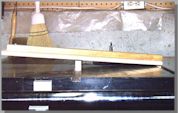
Compound miter sled for 12-sided 70-degree side angle.
|
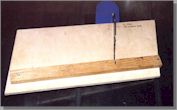
Another view of the compound miter sled at left. Note that the
saw blade is square to the saw table top.
|
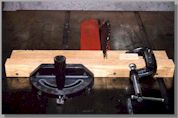
This is a simple compound miter cutting fixture attached to a
miter gauge.
|
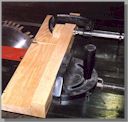
Another view of the compound miter cutting fixture at left.
Note that this fixture requires the blade to be tilted.
|
My sleds are made from 1/2" Baltic birch plywood. I like Baltic
birch plywood
because it seems to be dimensionally stable and stays flat. I make my
fence and runners
out of 1x4 oak or maple. You might note that my runners don't fit tight
in the miter gauge
slots. When I glue the runners to the sled, I hold the runners tight
against the outside
of the miter gauge slots so the sled assembly fits tightly in the miter
gauge slots, but
if the sled is too tight in the slots I only have to sand the outside
of the right-hand
runner to make the fit looser. Conversely, if the fit is too loose, I
only have to modify
the outside of the right-hand runner, such as by gluing on a veneer
strip.
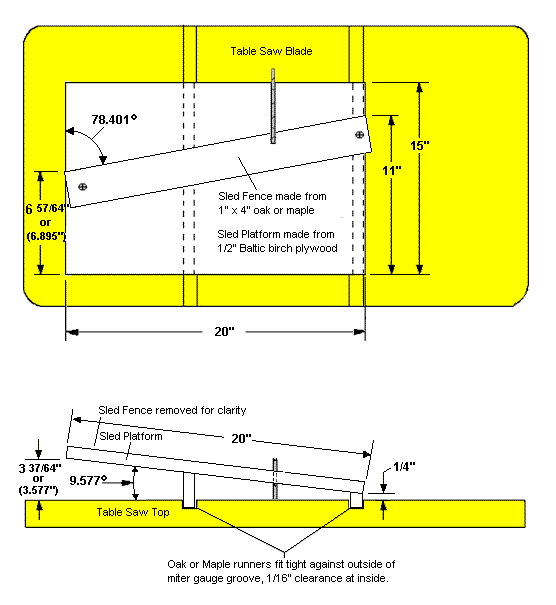
Instructions for making a sled for 12-sided 50-degree
compound mitered rings:
1. First we'll make the sled platform. Cut the sled from Baltic
birch plywood
15" by 20". The 20" dimension should be cut very accurately.
2. Cut two 15" lengths of 1x4 oak (or maple) runner. Set your
table saw blade
angle for 9-1/2 degrees and rip one long edge of each of the 15"
lengths of oak
runner. Readjust your blade angle to 0 degrees.
3. Measure the depth of your miter gauge groove. On my table
saw, the miter gauge
groove depth is 3/8". Rip one of the 15" lengths of oak runner so that
1/4"
of its right-hand side of its mitered top extends out of the miter
gauge groove. Refer to
the above sketch. The 1/4" dimension should be cut very
accurately.
4. Test fit the two runners into their respective miter gauge
grooves. They should
both fit loose. If they don't fit loose, then you should make them
thinner by whatever
handy means you have, such as by sanding.
5. Attach the right-hand runner to the bottom of the sled. I
usually glue it on,
then drive in a couple of brads for good measure.
6. Set the sled on the saw table with the sled's right-hand
runner in it's miter
gauge groove, tight against the right-hand side of the groove. Block up
and shim the
left-hand side of the sled so that the so that the left-hand lower
corner of the sled is exactly
3-37/64" from the table top. Don't block up too close to the left-hand
miter gauge
groove because we need access there. Refer to the above sketch. The
sled is now at the
correct angle (9.577 degrees).
7. Measure for the height of the left-hand runner by measuring
from the bottom of
the left-hand miter gauge groove, on the left-hand side of the slot, to
the underside of
the sled. Rip the remaining 15" oak runner so it will fit exactly in
this space. If
you cut the runner a hair too wide, with the intention of fine-tuning
its width later,
this wouldn't be a bad idea.
8. Put the newly-cut runner in place under the sled and take
out the blocks and
shims. Make sure the left-hand runner is tight against the left-hand
side of its miter
gauge groove and the right-hand runner is tight against the right-hand
side of its miter
gauge groove. Re-measure from the table top to the left-hand lower
corner of the sled.
Again, this distance should be exactly 3-37/64". Cut or shim
the left-hand
runner to obtain this dimension. Finally, glue and brad the runner into
place. The sled's
fit in the miter gauge grooves should have no slop. If the fit is too
tight, you can sand
later. If the fit is too loose, now's the time to remove the left-hand
runner, before the
glue dries, and readjust its location.
9. Now we'll make and install the sled's fence. Cut a 24"
length (not a
critical length) of flat 1x4 oak. Make sure one one of the 3/4" sides
is very
straight. If it isn't straight, rip it, joint it or whatever to get it
straight.
10. Make two marks on the sled, exactly 11" up from the
near
right-hand corner and exactly 6-57/64" up from the near
left-hand corner.
Refer to the above sketch.
11. Lay the 24" long 1x4 oak fence on the sled, with the
straight edge
oriented away from you. Line up and clamp the right-hand end of the
fence at the 11"
mark. Line up and clamp the left-hand end of the fence at the 6-57/64"
mark. Attach
the the right-hand end of the fence to the sled using a wood screw.
Leave the left-hand
end of the fence clamped so it can be adjusted. The fence can be
permanently attached to
the sled later. The fence is now at the correct angle (78.401
degrees). Glue a strip
of fine sandpaper the opposite edge of the fence to prevent slippage of
the boards you'll
be cutting. You can add hold-down clamps and other accessories to the
sled at this point.
12. Put the sled on the table saw top and check its fit. If it
fits OK then you're
ready to make a test piece to check the sled's angle settings.
13. For the mathematically-inclined woodturners that want to
build a custom sled
for a different compound miter, the sled equations are as follows:
D = E - C / Tan( MiterGaugeAngle
) and
B = A + C * Sin( BladeAngle )
To download an Excel spreadsheet that calculates
frame miter sled dimensions as well as compound miter sled dimensions:
click here.
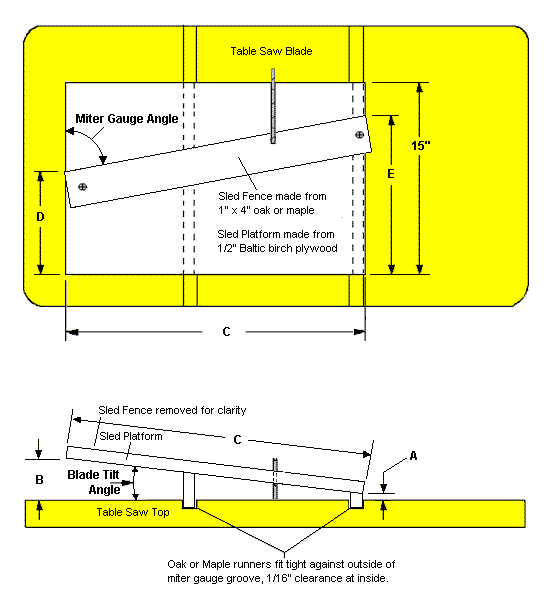
14. First we'll test squareness of the table saw blade. Unplug
the table saw and
raise the saw blade to its full height. Square the blade to the saw
table as accurately as
you can with a good square. Be sure that the table saw's blade insert
isn't throwing off
your readings. Plug in the table saw. As a recheck for blade
squareness, using your miter
gauge, cut the thickest board that your blade will cut (say, a 1x3 on
edge, with the
3" side vertical). Check the cut squareness with your square. Turn the
board over and
recheck the cut squareness again from the other edge. Both square
checks should agree. If
they don't agree, your square is not square. Readjust saw blade
squareness as necessary.
This step is the reason that I make compound miter sleds using this
design...because I
hate to re-square my table saw blade.
15. Now we'll set up for the test piece. Use a length of the
1x4 oak (or maple) to
make the test piece. The test piece consists of a half-ring of segments
glued together. We
could make a full-ring as a test piece, but a half-ring only takes half
as long to make.
Rip the test piece so its long side edges are parallel. This step is
necessary for
accurate repetitive segment cutting (the thickness should be reasonably
the same, too).
Place your new compound miter sled in the table saw miter gauge groves.
Make sure that
there's no sawdust in the grooves. Make sure the runners bottom in the
grooves. Raise the
saw blade to its full height. Push the sled into the blade, cutting
just into the fence. Don't
push downward on the sled platform to the left of the left
runner because
the sled will tip, binding the saw blade. Place the 1x4 board against
the sled fence so
that about 4" is to the right of the blade's sawcut. Cut off this
piece, which will
be used as the board stop. Flip the 1x4 board over edge-to-edge (do NOT
flip end-to-end)
and align against the sled fence so that about 1-1/2" is to the right
of the blade's
sawcut. Butt the board stop against the end of the 1x4 and clamp the
board stop into
place. It's very important to use a board stop so the segments will be
cut exactly the
same width.
16. Next we'll cut the test piece. Butt the 1x4 board against
the board stop. Make
sure that there's no sawdust between the end of the 1x4 board and the
board stop. Hold the
1x4 board tight against the fence so it doesn't slip either direction
(the saw blade will
tend to push the 1x4 board to the left as you cut). Cut off the first
segment. Don't push
fast. You'll get a better cut if you go a little slow. If you put
hold-downs on your sled,
install hold-downs for both the board and the cutoff segment. Cut six
test segments.
Remember, we're cutting six segments because we're cutting a half-ring
of a 12-sided ring.
If for some reason, any of the six segments are miscut, then cut
another one to replace
it.
17. Lightly sand the six test segments, then glue them
together. If you're
interested in what kind of glue I use...it's Titebond II. Since it's
very difficult to
clamp these odd-shaped segments together for gluing, I use
rubber-bands. I rubber-band
pairs together, then I rubber-band pairs of pairs together, etc.
Click on the photos for an enlarged view.
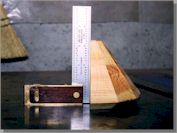
Fig.1 Compound miter sled half-ring test piece.
|
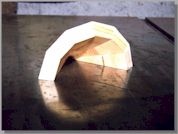
Fig.2 Compound miter sled half-ring test piece.
|
18. Now, we'll inspect the test piece for sled fence
adjustment. Place the test
piece on your saw table saw top with the cut edges vertical, like in
Figure 1. Using your
square, check squareness of the test piece. It should be square.
(Before you make any
fence adjustments, mark the starting fence position by making a light
pencil mark on both
sides of the fence.) If the test piece touches the square at bottom
but not the
top, then move the left side of the sled fence away from you
about 1/16" and
make a small light pencil mark on the sled for new fence position.
Conversely, if the test
piece touches the square at top but not the bottom, then move the left
side of the sled
fence toward you.
19. Now, we'll inspect the test piece for sled platform angle.
Place the test
piece on your saw table top with the cut edges down, like in Figure 2.
(If the test piece
rocks a lot, then there is something wrong with the way one or more of
the test segments
was cut, such as different segment widths or angles or maybe the edges
aren't lined up
good enough.) The cut edges should completely contact the table top
surface. In Figure 2,
look at the 3/4" wide edge of the test piece in the foreground. (Click
on the photo
for an enlarged view.) Note that the right-hand corner of the edge
contacts the table top
but the left-hand corner of the edge is slightly off the table top.
This test piece is
actually pretty close and I would just sand the half-ring flat for use.
But, if the left-hand
corner had more gap with the table top, then you need to glue a
piece of veneer to the
bottom of the left-hand sled runner. Conversely, if the right-hand
corner
had a gap with the table top, then you need to glue a piece of veneer
to the bottom of the
right-hand sled runner.
20. Make your adjustments to the sled as necessary and make
another test piece.
Readjust as necessary. Good luck.
This page and its source
code is
Copyright 2020 by Kevin's Woodturnings
All rights reserved. World rights reserved.








